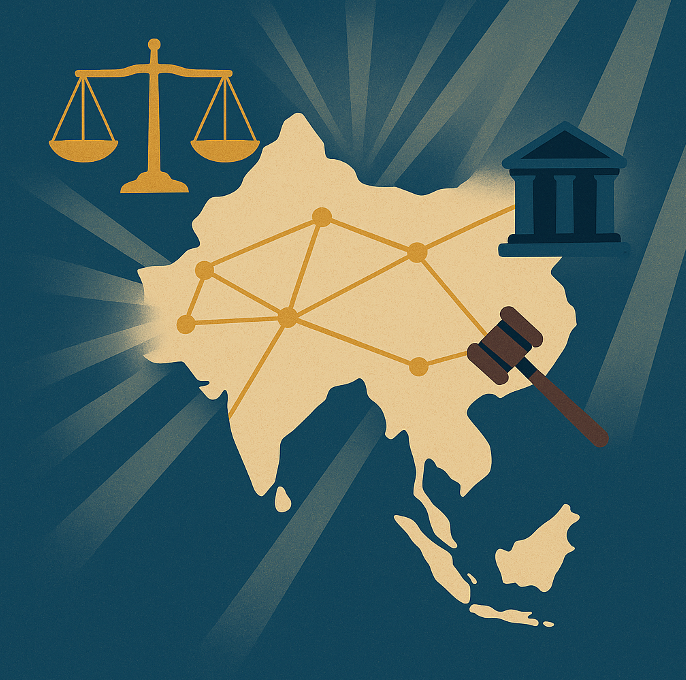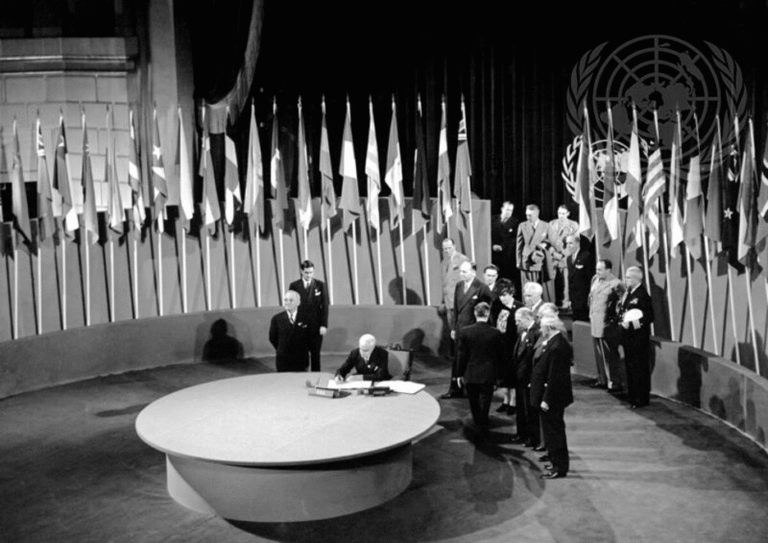By Rashmi Raman
In this short piece I set out to interrogate how international law’s temporal grammar both registers and erases the slow violence of starvation in Gaza. I begin by situating the argument within the broader concept of long and slow violence, drawing on critical scholarship to explain how attritional harm becomes legally invisible when it unfolds cumulatively rather than as a punctual event. From there I examine what I term the event form of law, showing how the Rome Statute’s framing of starvation as a method of warfare privileges discrete acts and snapshot evidence over non-linear and often operationally obscured sequences of deprivation and infrastructural degradation. This leads into a reflection on legal memory and forgetting, following Frédéric Mégret’s recent piece on Biafra to reveal how legal remembrance is selective and how ongoing harms are displaced when they are archived as past.
I then move to the politics of jurisdictional time, drawing on critical scholarship to expose the colonial underpinnings of legal time and the way procedural delay transforms urgent harms into historical conditions. I integrate Mohsen al Attar’s recent counterfactual approach to argue for a jurisprudence of the not yet, one that forces institutions to anticipate and prevent cumulative injury. Building on this, I articulate the starvation continuum as a legal object and propose evidentiary reforms that would allow cumulative proof to take precedence over isolated incidents. I then address the need to shift from chronos to kairos, engaging Michael Fakhri’s right to food framework to argue for preventive legality that acts within the narrow temporal window in which life can still be sustained. I conclude with doctrinal proposals designed to institutionalise memory of sequences and infrastructures, ensuring that law remembers what it is structurally predisposed to forget. The structure moves from diagnosis to critique to prescription, weaving together theory, legal doctrine, and methodological innovation.
Introduction: Legal Time, Slow Violence, and the Colonial Optic
International law privileges punctual harms and discrete violations, which produces systematic blindness to harm that is cumulative, incremental, and administratively routinised. In an international law frame, chronos refers to the sequential, measurable time of legal processes such as treaty timelines, procedural deadlines, or adjudicatory stages, while kairos denotes the opportune or critical moment when political conditions, normative shifts, or crises make certain legal actions or arguments most impactful. As I have argued elsewhere, Gaza’s starvation is paradigmatic of long and slow violence, a modality that unfolds as protracted deprivation through infrastructural sabotage and bureaucratic throttling of relief. Rob Nixon’s formulation of slow violence clarifies the political economy of invisibility that accompanies attritional harm and explains why juridical forums struggle to register injury that lacks in the immediacy of spectacle.
In the juridical discourse of international law, the vocabulary of hunger now operates alongside the category of food insecurity, which denotes a sustained inability to secure the minimum nourishment required for survival. In the case of Gaza, such deprivation arises not from ecological contingency but from deliberate political and military conduct. This represents a temporal and conceptual shift from the historical meaning of famine, once linked to drought and other natural scarcities embedded in the measurable time of chronos. The transformation reflects an epistemic move towards kairos, where the decisive moment for intervention is located before the culmination of mass death. This shift was operationalised two decades ago with the creation of the Integrated Food Security Phase Classification (IPC), which replaced retrospective death-count metrics with a phased early-warning system. The IPC identifies five stages, colour-coded from near-normal to catastrophe or famine, thereby institutionalising a temporality of anticipatory governance in which law and policy are oriented toward prevention rather than post-mortem recognition.
The International Court of Justice, in its 28 March 2024 Order in the South Africa v. Israel proceedings, engaged this kairos framework directly. Citing the IPC’s warning of imminent famine, the Court treated this assessment as a “material change in circumstances” that justified the modification of provisional measures. The Order declared that “famine is setting in” and required Israel to ensure unimpeded delivery of food, water, and medical assistance, reframing famine in the law not as an historical endpoint but as an unfolding present that demands immediate juridical intervention. In doing so, the Court’s reasoning foregrounds temporality as a site where the authority to act is triggered at the critical moment when prevention remains legally and materially possible.
The move from chronos to kairos is not metaphor. It is a design brief for institutions. Michael Fakhri’s right to food reports and public interventions situate starvation as a human rights violation that demands anticipatory governance even if that were to take the form of the (by-now-expletive) humanitarian assistance. That approach translates into hard triggers for access corridors, presumptions in favour of immediate facilitation of relief, and standing authorisations that make obstruction a per se violation that engages responsibility in real time. It is exactly in a context like Gaza, where food systems have been devastated and agriculture rendered impossible, that kairotic legality must function. Otherwise famine remains a foreseeable outcome to be managed after the fact…
Event Form versus Accumulation: Why Starvation Disappears
At the front and centre of the international community’s concern over the human rights crisis in Gaza is therefore the question of humanitarian aid, assistance and the creation and maintenance of open corridors for the passage of goods and services essential to saving human lives in the face of endless cycles of violence and brutality, now 676 days (and counting) after the armed conflict began. The Rome Statute criminalises starvation as a method of warfare, yet liability is commonly narrated as an identifiable act and not a concatenation of measures that are aimed at slowly reducing subsistence to zero. This event form of international legal grammar privileges snapshots over sequences and therefore encourages forensic myopia about rationing schedules, agricultural incapacitation, and the deliberate military patterns obstructing aid corridors. Contemporary scholarship on siege starvation shows how doctrinal architecture has historically cordoned the crime within narrow evidentiary frames, even as starvation in practice is assembled through long causal chains that law treats as background.
The Starvation Continuum as Legal Object
To treat starvation as a legal object that exists along a continuum, doctrine must accommodate cumulative proof. Alex de Waal’s typology of the purposes of starvation shows that famine is usually embedded in layered strategies rather than singular commands. Evidence should therefore track sequences, for example nutrition surveys across districts, market price inflation correlated with checkpoint closures, and destruction of orchards and fisheries aligned with operational campaigns. The continuum frame aligns legal method with the materialities of subsistence rather than the theatrics of events.
Memory as Method: From Biafra’s Afterlives to Gaza’s Present
Frédéric Mégret’s recent reflection on remembering Biafra is not a detour into Nigerian history. It is a method for thinking about time in international law. The argument that international law participates in selective remembrance and strategic oblivion enables a critique of legal temporality that is directly applicable to Gaza. Law remembers what it can locate as a bounded event and forgets what is extended, recursive, and infrastructural. The analytic lesson is that famine is juridically displaced when it is archived as past or normalised as ambient. Applying that lesson to Gaza, the question is how legal memory can be reconfigured so that slow violence is recalled as an ongoing legal object rather than consigned to the museum of tragedies. The point of invoking Biafra here is not to monumentalise another catastrophe. It is to expose how legal memory selects for punctuality and how that selection reproduces colonial hierarchies of credibility and urgency. A memory practice attentive to slow violence would require institutions to remember sequences and infrastructures rather than only orders and battles. In Gaza that would mean institutionalising baselines for food systems, tracking attrition over time as a primary evidentiary object, and refusing procedural closures that convert ongoing deprivation into a closed chapter. Mégret’s insight about remembrance and oblivion thus becomes a protocol for attending to attrition that is designed to be forgettable.
Jurisdictional Lag and Counterfactuals as Anti-Forgetfulness
Third World Approaches to International Law (TWAIL) scholarship has long insisted that law’s temporality is imperial, with schedules and thresholds that sort whose suffering qualifies as urgent. Balakrishnan Rajagopal’s work on law from below begins an important conversation on how the architecture of legality disaggregates structural domination into administratively manageable episodes, thereby obscuring longue durée injuries. That optic combines with jurisdictional lag to produce a time politics where investigations and trials operate on multi-year calendars while famine physiology turns on months and years, if not generations. The effect is juridical complicity through delay, which converts present emergency into archived history.
Mohsen al Attar’s recent thought provoking counterfactual series on Gaza operationalises a jurisprudence of the not yet. By insisting on futures that must be imagined in the present, the series dislodges the reactive temporality that keeps international law forever late. Counterfactual method interrupts the drift toward memorialisation without prevention because it obliges doctrine to account for the choices that would avert the next absence of food, water, market access, and arable capacity. In this register, counterfactuals are not literary devices. They are temporally disciplined tools for forcing law to act before cumulative injury becomes irreversible.
Design Consequences: Three Immediate Doctrinal Moves
First, adopt a presumption of continuity for starvation claims that links blockade phases, import restrictions, and agricultural destruction into a single course of conduct, with the burden on the occupying power and forces to rebut continuity. Second, recalibrate evidentiary rules to privilege aggregated indicators and longitudinal series over isolated proof points, so that cumulative harm is legible as harm. This is perhaps the hardest to translate into law because it requires reimagining law as we know it. Third, integrate counterfactual analysis into precaution and necessity assessments, so that decision makers must model minimally rights-impairing alternatives ex ante rather than rationalise attrition ex post. These moves convert memory work and temporal critique into enforceable legal method.
Conclusion: Making Law Remember What It Prefers to Forget
If international law continues to treat starvation as an event rather than a process it will keep arriving after the famine. A TWAIL grammar of time, informed by critical memory work and counterfactual practice, makes it possible to see Gaza’s starvation as a legally cognisable continuum that demands immediate intervention rather than retrospective elegy. The prohibition on starvation acquires force only when institutions are designed to remember sequences, to measure accumulation, and to act within the opportune window where life can still be sustained. The harsh fact is that this window has, in all likelihood, already closed.
About the Author
Rashmi Raman is a Research Fellow at the Centre for International Law, National University of Singapore. A brief bio of the author can be found here.





